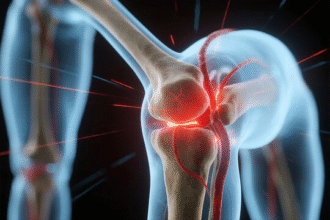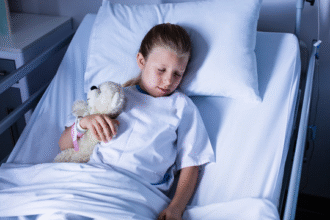Key Points
- Chronic, idiopathic inflammatory bowel disease limited to the colon and rectum, marked by continuous mucosal ulceration.
- Presents with bloody diarrhea, urgency, tenesmus, and abdominal cramping.
- Diagnosed by colonoscopy with biopsy showing continuous inflammation, pseudopolyps, and crypt abscesses.
- Treatment includes aminosalicylates, corticosteroids for flares, immunomodulators, biologics, and surgery for refractory or dysplastic disease.
- Long-term monitoring essential for colorectal cancer prevention and management of extraintestinal manifestations.
Introduction
Ulcerative colitis (UC) is a chronic inflammatory condition of the colon characterized by continuous mucosal inflammation starting in the rectum. The exact etiology is unknown but involves genetic susceptibility, dysregulated immune response, and environmental triggers.
Epidemiology
- Prevalence: 120–200 per 100,000 in North America and Europe; incidence rising in Asia.
- Age at onset: biphasic peaks at 15–30 and 50–70 years.
- Gender: roughly equal distribution between men and women.
Pathophysiology
- Genetic factors: HLA associations (HLA-DRB1*01:03).
- Immune dysregulation: Th2-like cytokine profile, elevated TNF-α.
- Barrier dysfunction: increased epithelial permeability and altered microbiota.
- Continuous inflammation confined to mucosa and submucosa.
Clinical Presentation
Gastrointestinal Symptoms
- Bloody diarrhea (often >10 stools/day).
- Abdominal cramping and pain, typically LLQ.
- Urgency and tenesmus.
- Systemic features: fever, malaise, weight loss.
Extraintestinal Manifestations
- Arthralgia and arthritis.
- Dermatologic: erythema nodosum, pyoderma gangrenosum.
- Ocular: uveitis, episcleritis.
- Hepatobiliary: primary sclerosing cholangitis.
Diagnostic Evaluation
Laboratory Tests
- CBC: anemia, leukocytosis.
- ESR/CRP: elevated during active disease.
- Fecal calprotectin: marker of intestinal inflammation.
Endoscopy and Histology
- Colonoscopy: continuous mucosal erythema, friability, ulceration, pseudopolyps.
- Biopsy: crypt architectural distortion, crypt abscesses, mucosal ulceration.
Imaging
- Flexible sigmoidoscopy may suffice in severe flares.
- CT/MRI enterography: evaluate extent and complications (toxic megacolon).
Differential Diagnosis
- Crohn’s disease (skip lesions, transmural involvement).
- Infectious colitis (Clostridioides difficile, Salmonella).
- Ischemic colitis.
- Irritable bowel syndrome (functional).
Management
Induction of Remission
- Aminosalicylates: mesalamine, sulfasalazine.
- Corticosteroids: oral or IV for moderate–severe flares.
- Biologics: infliximab, adalimumab, vedolizumab for steroid-refractory disease.
- Immunomodulators: azathioprine, 6-mercaptopurine.
Maintenance Therapy
- Continue aminosalicylates or immunomodulators.
- Monitor drug levels and adverse effects.
Surgical Intervention
- Indications: refractory disease, dysplasia, carcinoma, or complications (e.g., toxic megacolon).
- Restorative proctocolectomy with ileal pouch–anal anastomosis (IPAA) is curative.
Nursing Considerations
- Monitor stool frequency, consistency, and volume.
- Assess fluid and electrolyte status; manage dehydration.
- Educate on medication adherence and side effects.
- Provide nutritional support: high-calorie, low-residue diet during flares.
- Support psychosocial needs and coordinate care with multidisciplinary team.
Prognosis and Surveillance
- Many achieve remission, but relapses are common.
- Risk of colorectal cancer increases after 8–10 years of disease; colonoscopic surveillance recommended every 1–3 years.
- Manage extraintestinal complications proactively.
Patient Education
- Emphasize importance of medication compliance and regular follow-up.
- Advise on dietary modifications and smoking cessation (protective effect in UC).
- Teach recognition of flare signs: increased stool frequency, bleeding, and systemic symptoms.
References
- Ungaro R, Mehandru S, Allen PB, Peyrin-Biroulet L, Colombel JF. Ulcerative colitis. Lancet. 2017;389(10080):1756–1770.
- Rubin DT, Ananthakrishnan AN, Siegel CA, Sauer BG, Long MD. ACG Clinical Guideline: Ulcerative Colitis in Adults. Am J Gastroenterol. 2019;114(3):384–413.
- Harbord M, Eliakim R, Bettenworth D, et al. Third European Evidence-based Consensus on Diagnosis and Management of Ulcerative Colitis. J Crohns Colitis. 2017;11(6):649–670.
- Ricciuto A, Griffiths AM. Management of pediatric ulcerative colitis. Gastroenterology. 2020;158(8):2150–2163.







